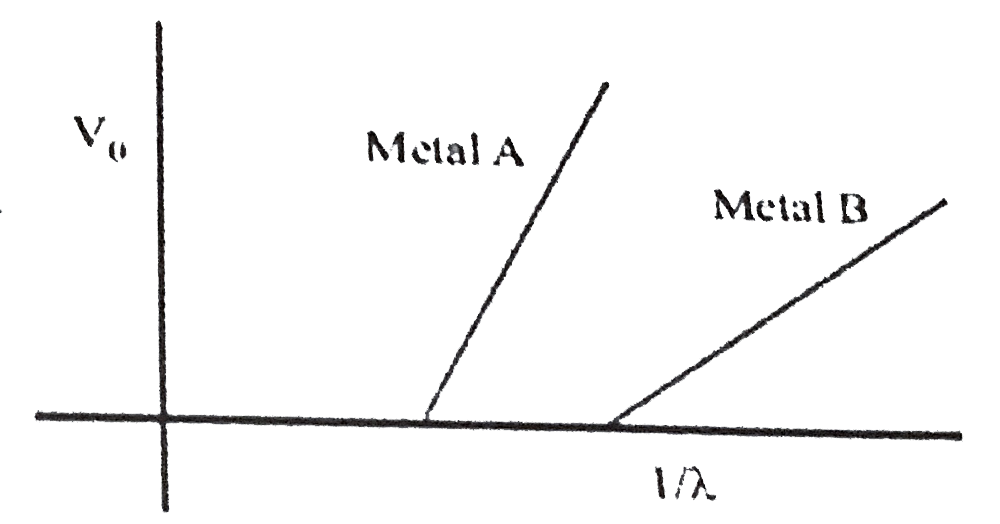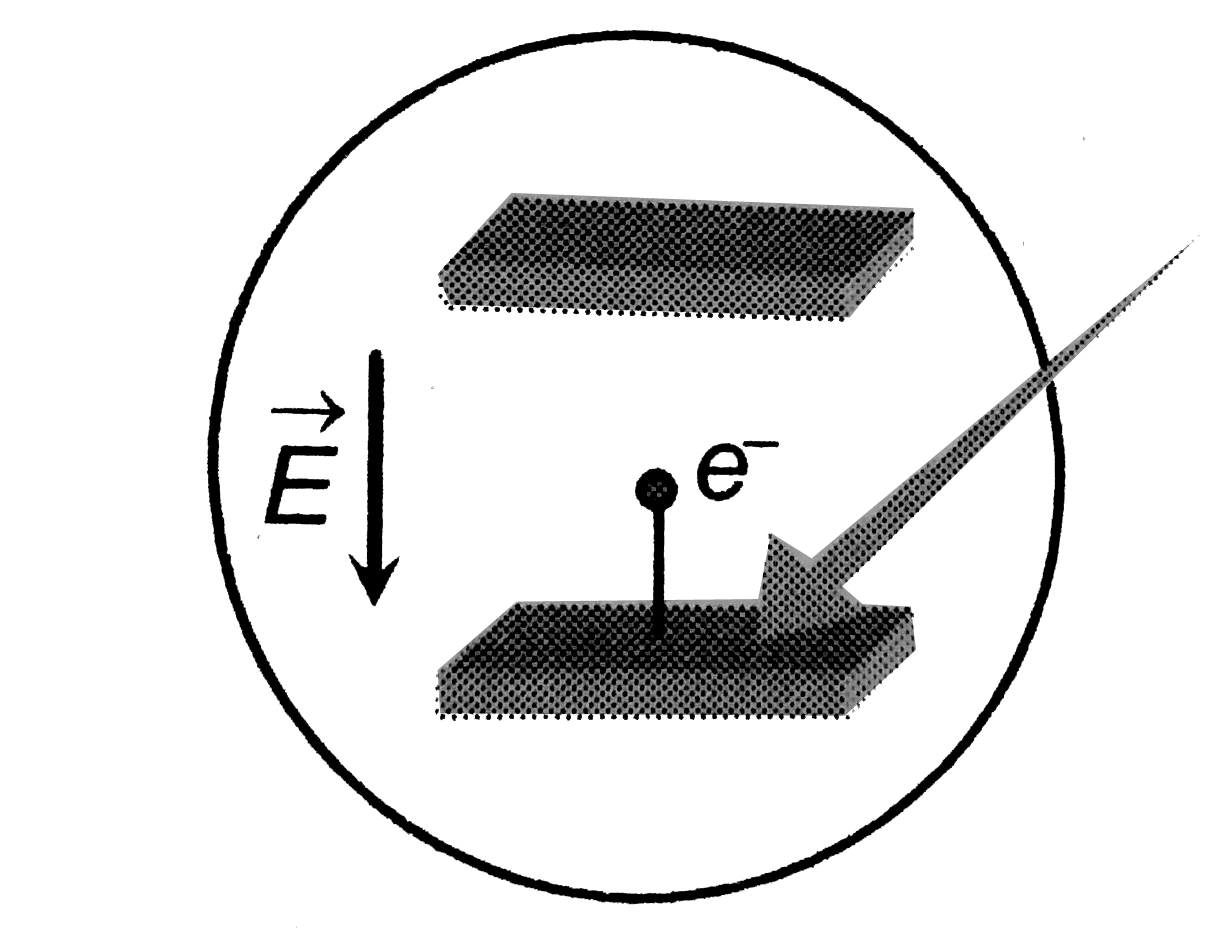Complete Solutions to WB JEE WORKOUT of chapter PARTICLE NATURE OF LIGHT AND WAVE PARTICLE DUALISM of Class 12 book with complete answers and questions
| Class 12 | PHYSICS |
| Chapter | PARTICLE NATURE OF LIGHT AND WAVE PARTICLE DUALISM |
| MTG-WBJEE | WB JEE WORKOUT |
| Number Of Questions | 55 |
| Academic Year | 2023-24 |
What is the work function of a substance if photoelectrons are just ejected for a monochromatic light of wavelength
`lambda = 3300` Å (answer in eV) ?
View SolutionThe stopping potential of a photoelectric diode is 9 volts. `e//m = 1.8 xx 10^(11) C kg^(-1)` , then what is its velocity ?
View SolutionIf `g_E` and `g_M` are the acceleration due to gravity on the surfaces of the earth and the moon respectively and if Millikan's oil drop experiment could be performed on the two surfaces, one will find the ratio
electronic charge on the moon/electronic charge on the earth to be
View SolutionIn an experiment on photoelectric effect, a student plots stopping potential `V_(0)` against reciprocal of the wavelength `lamda` of the incident light for two different metals A and B. These are shown in the figure

Looking at the graphs, you can most appropriately say that :
View Solutionwhen a monochromatic point source of light is at a distance 0.2 m from a photoelectric cell, the saturation current and cut-off voltage are 12.0 mA and 0.5 V. If the same source is placed 0.4 m away from the photoelectric cell, then the saturation current and the stopping potential respectively are
View SolutionThe photoelectric threshold wavelength for silver is `lamda_(0)`. The energy of the electron ejected from the surface of silver by an incident wavelength `lamda(lamdaltlamda_(0))` will be
View SolutionA and B are two metals with threshold frequencies `1.8 xx 10^(14)Hz` and `2.2 xx 10^(14)Hz`. Two identical photons of energy 0.825 eV each are incident on them. Then, photoelectrons are emitted by (Taking, `h = 6.6 xx 10^(-34)J-s`)
View SolutionMonochromatic light of frequency `6xx10^(14)Hz` is produced by a laser. The power emitted is `2xx10^(-3)` W.
The number of photons emitted per second is
`("Given h"=6.63xx10^(-34)Js)`
View SolutionA photon of energy h`upsilon` and momentum `h upsilon` /c collides with an electron at rest. After the collision, the scattered electron and the scattered photon each make an angle of `45^@` with the initial direction of motion. The ratio of frequency of scattered and incident photon is
View SolutionConsider the four gases hydrogen, oxygen, nitrogen and helium at the same temperature. Arrange them in the increasing order of the de Broglie wavelengths of their molecules.
View SolutionAn electron and proton have the same de-Broglie wavelength. Then the kinetic energy of the electron is
View SolutionA metallic surface is irradiated with monochromatic light of variable wavelength. Above a wavelength of `5000 Å` no photoelectrons are emitted from the surface. With an unknown wavelength, stopping potential fo 3V is necessary ot eliminate the photo current. Find the unknown wavelength.
View SolutionElectrons with de-Broglie wavelength `lambda` fall on the target in an X-ray tube. The cut-off wavelength of the emitted X-ray is
View SolutionLight described at a place by te equation `E=(100 V/m) [sinxx(10^15 s ^(-1) t) +sin (8xx 10^15 s^(-1) t)]` falls on a metal surface having work function 2.0 eV. Calculate the maximum kinetic energy of the photoelectrons.
View SolutionTwo identical photocathode receive light of frequencies `f_(1)` and `f_(2)`. If the maximum velocities of the photoelectrons (of mass m) coming out are respectively `v_(1)` and `v_(2)` then:
View SolutionThe work function of a certain metal is `(hC)/lambda_(0)`. When a monochromatic light of wavelength `lambda lt lambda_(0)` is incident such that the plate gains a total power `P`. If the efficiency of photoelectric emission is `eta%` and all the emitted photoelectrons are captured by a hollow conducting sphere of radius `R` already charged to potential `V`, then neglecting any interaction of potential of the sphere at time `t` is:
View SolutionAfter absorbing a slowly moving neutrons of mass `m_(N)` (momentum ~0) a nucleus of mass M breaks into two nucleii of mass `m_(1) and 5m_(1)(6m_(1)=M+m_(N))`, respectively . If the de-Broglie wavelength of the nucleus with mass `m_(1) ` is ` lambda`, then de Broglie wavelength of the other nucleus will be
View SolutionA point source causes photoelectric effect from a small metal plate. Which of the curves in figure 8 may represent the saturation photo-current as a function of the distance between the source and the metal?

View SolutionAn electron of mass `m` and charge `e` initially at rest gets accelerated by a constant electric field `E`. The rate of change of de-Broglie wavelength of this electron at time `t` ignoring relativistic effects is
View SolutionAll electrons ejected from a surface by incident light of wavelength 200nm can be stopped before traveling 1m in the direction of a uniform electric field of `4 NC^(-1)`. The work function of the surface is
View SolutionThe stopping potential as a function of the frequency of the incident radiation is plotted for two different photoelectric surfaces `A` and `B` . The graphs show that work function of `A` is

View SolutionAn AIR station is broadcasting the waves of wavelength `300 metres`. If the radiating power of the transmitter is `10 kW`, then the number of photons radiated per second is
View SolutionA source `S_(1)` is producing `10^(15)` photons/s of wavelength `5000 Å` Another source `S_(2)` is producing `1.02 xx 10^(15)` photons per second of wavelength `5100 Å`. Then `("power of" `S_(2))/("power of" S_(1))` is equal to
View SolutionRadiations of frequencies `8xx10^(15)` Hz and `5xx10^(15)` Hz are incident one after the another on the same photosensitive surface. If is found that the kinetic energies of the photo electrons emitted from the surface are in the ratio of 2:1 . What is the threshold frequency for the surface ?
View SolutionThe work function of lithium is 2.5 eV. what is the maximum wavelength of light that can cause the photoelectric effect in lithium?
View SolutionX-rays of frequency u were used to irradiate sodium and copper surfaces in two separate experiments and their stopping potentials were found to be Na and V' cu If the work function of `Cu gt` work function of Na, then
View SolutionThere are `N_(1)` photons of frequency `v_(1)`, in a beam of light, In another light beam of equal energy there are `N_(2)` photons of frequency `v_(2)`. Then `N_(1)` and `N_(2)` are related as
View SolutionA dust particle of mass 2 mg is carried with a velocity of 100 cm/s. What is the de Broglie wavelength associated with the dust particle? `(h = 6.64 xx 10^(-34) J-s)`
View SolutionWhen the mkomentum of a proton is changed by an amount `p_(0)`, the corresponding change in the de-Broglie wavelength is found to be `0.25%`. Then, the original momentum of the proton was
View SolutionThe de Broglie wavelength of an electron moving with a velocity c/2 (c=velocity of light in vacuum) is equal to the wavelength of a photon. The ratio of the kinetic energies of electron and photon is
View SolutionWhen a certain metal surface is illuminated wth light of frequency v, the stopping potential for photoelectric current is `V_(0)`. When the same surface is illumiinated by light of frequency `(v)/(2)`, the stopping potential is `(V_(0))/(4)`. The threshold frequency ofr photoelectric emissiohn id
View SolutionPhotoelectric effect experiments are performed using three different metal plates `p,q` and`r` having work function `phi_(p) = 2.0 eV, phi_(e) = 2.5 eV and phi_(r) = 3.0 eV` respectively A light beam containing wavelength of `550nm , 450 nm` and `350nm ` with equal intensities illuminates each of the plates . The correct `I -V` graph for the experiment is [Take hc = 1240 eV nm]
View SolutionA beam of 450 nm light is incident on a metal having work function 2eV and placed in a magnetic field B. If the most energetic electrons emitted are bent into circular are of radius 0.2 m, find B.
View SolutionFigure represents a graph of kinetic energy of most energetc photoelectrons, `K_(max)` (in eV), and frequency `(epsilon)` for a metal used as cathode in

Photoelectric experiment , The threshold frequency of light for the photoelectric emission from the metal is
View SolutionRadiation from a hydrogen discharge discharge tube is incident on the cathode ofa photocell having energy 3.4 eV .The work function of the cathode suface is 3.2 eV. To reduce the photocurrent to zero, the voltage (in volts) of th anode realtive to the cathode must be made
View SolutionIf a source of power `4 kW` produces `10^(20)` photons`//`second, the radiation belongs to a part of the spectrum called:
View SolutionWhen light of wavelength `lambda` is incident on a metal surface, stopping potential is found to be x. When light of wavelength n`lambda` is incident on the same metal surface, stopping potential is found to be `(x)/(n+1)` . Find the threshold wavelength of the metal.
View SolutionIn an experiment on photoelctric effect, light of wavelength `800 nm` ( less than threshold wavelength) is incident on a cessium plate at the rate of `5.0W`. The potential of the collector plate is made sufficiently positive with respect to the emitter so that the current reaches its saturation value. Assuming that on the average one of every `10^(6)` photons is able to eject a photoelectron, find photo current in the circuit.
View SolutionA silver of radius `1 cm` and work function `4.7 eV` is suspended from an insulating thread in freepace. It is under continuous illumination of `200 nm` wavelength light. As photoelectron are emitted the sphere gas charged and acquired a potential . The maximum number of photoelectron emitted from the sphere is `A xx 10^(e) (where 1lt A lt 10)` The value of `z` is
View SolutionA monochromatic light of frequency f is incident on two identical metal spheres of threshold frequency `f/2` and `f/3` respectively. After some time, emission of photoelectron will stop on both spheres . Now both metal spheres are connected through wire. (radius of spherhes is R )
(a)What will be potential of spheres now ?
(b)how many electron will flow through wire ?
View SolutionA silver ball of radius 4.8 cn is suspended by a thread in a cacuum chamber, Ultraviolet light of wavelength 200nm is incident on the ball for some time during which a total light energy of ` 1.0 xx (10^-7)` J falls on the surface. Assuming that on the average one photon out of every ten thousand is able to eject a photoelectron, find the electric potential at the surface of the ball assuming zero potential at infinity. What is the potential at the centre of the ball?
View SolutionA hydrogen atom moving at a speed v absorbs a photon of wavelength 122 nm and stops. The value of v is (mass of hydrogen atom `=1.67xx10^(-27)` kg)
View SolutionIn a photoelectric experiment it was found that the stopping potential decreases from 1.85 V to 0.82 V as the wavelength of the incident light is varied from 300 nm to 400 nm. Calculate the value of the Planck constant from these data.
View SolutionA metal surface is illuminated by light of two different wavelengths 248 nm and 310 nm. The maximum speeds of the photoelectrons corresponding to these wavelengths are `mu_1` and `mu_2` respectively. If the ratio `u_1: u_2 = 2:1 and hc= 1240 eV` , the work function of the metal is nearly.
(a)3.7 eV (b) 3.2 eV
(c ) 2.8eV (d) 2.5eV.
View SolutionAn image of the sun is formed by a lens, of the focal length of 30 cm, on the metal surface of a photoelectric cell and a photoelectric current I is produced. The lens forming the image is then replaced by another of the same diameter but of focal length 15 cm. The photoelectric current in this case is
View SolutionThe maximum kinetic energy of the emitted photoelectrons against frequency `epsilon` of incident radiation is plotted as shown in figure. This graph help us in determining the following physical quantities

View SolutionWhen a point light source, of power `W`, emitting monochromatic light of wavelength `lambda` is kept at a distance `a` from a small photosensitive surface of work function `phi` and area `S`. Then
View SolutionA photon collides with a stationary hydrogen atom in ground state inelastically. Energy of the colliding photon is 10.2 eV. After a time interval of the order of micro second another photon collides with same hydrogen atom inelastically with an energy of 15eV. What wil be observed by the detector?
(a) 2 photons of energy 10.2 eV
(b) 2 photons of energy 1.4 eV
(c ) One photon of energy 10.2 eV and an electron of energy 1.4 eV
(d) One photon of energy 10.2 eV and another photon of energy 1.4 eV
View SolutionAn electron in hydrogen atom first jumps from second excited state to first excited state and then from first excited state to ground state. Let the ratio of wavelength, momentum and energy of photons emitted in these two cases be a, b and c respectively, Then
View SolutionPhotoelectric effect supports quantum nature of light because
(a) there is a minimum frequency of light below which no photo electrons are emitted
(b) the maximum kinetic energy of photo electrons depends only on the frequency of light and not on its intensity
(c ) even when the metal surface is faintly illuminated, the photo electrons leave the surface immediately
(d) electric charge of the photo electrons is quantised
View SolutionThe collector plate in an experiment on photoelectric effect is kept vertically above the emitter plate . Light source is put on and a saturation photo current is recorded . An electric field is switched on which has a vertically downward direction . Then

View SolutionThe graph between the stopping potential `(V_0)` and `(1/lambda)` is shown in the figure `phi_1` , `phi_2` and `phi_3` are work functions. Which of the following is/are correct?

View SolutionThe work function of a metal is `4.0 eV`. If the metal is irradiated with radiation of wavelength `200` nm, then the maximum kinetic energy of the photoelectrons would be about.
View SolutionA proton has kinetic energy E = 100 keV which is equal to that of a photon. The wavelength of photon is `lamda_(2)` and that of proton is `lamda_(1)`. The ratio of `lamda_(2)//lamda_(1)` is proportional to
View SolutionWhen the intensity of a light source is increased
View Solution
WB JEE WORKOUT questions and complete solutions for chapter PARTICLE NATURE OF LIGHT AND WAVE PARTICLE DUALISM of MTG-WBJEE PHYSICS (HINGLISH) of Class 12